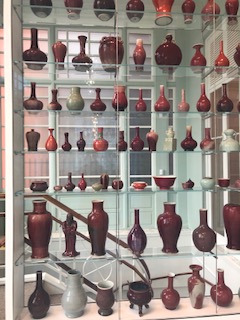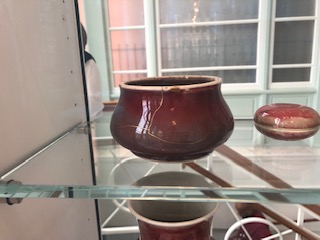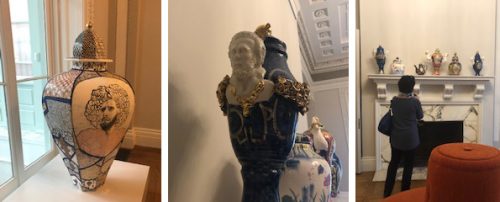Repairing Injuries With Gold

A blog post by Deputy Director Tracie Guy-Decker. Read more posts from Tracie by clicking HERE.
Repairing Injuries with Gold: 1 West Mount Vernon Place
One of the great perks of being a museum professional is visiting museums with other professionals. On Friday, December 21, I had double good fortune when Eleanor Hughes, Deputy Director for Art & Program at the Walters Art Museum hosted the JMM management team at the Walters’ historic site, 1 West Mount Vernon Place.


I had heard of Kintsugi before, though since my visit to 1 West Mount Vernon, I’ve learned a great deal more about it. “Golden Joinery” is a Japanese practice of repairing ceramic vessels with layers of lacquer mixed with precious medals. This repair technique is also a philosophy—one that highlights breakage and repair as moments to be honored and celebrated, rather than hidden from view. I find the notion and the Japanese practice deeply beautiful.
Eleanor begins her tours of 1 West Mount Vernon with this bowl to encourage visitors to think about the practice of kintsugi as a metaphor for what she and her team have done with the historic site that was once known as the Hackerman House. In their research and decision-making about the visitor experience, they’ve decided to foreground the stories not just of the owners of the home, but those of the people who served in the house. These latter stories include written evidence, including a letter written by her own hand, of a woman, Sybby Grant, enslaved by the original owners of the house. As Eleanor acknowledged, this choice was not universally embraced by those in the family and orbit of the Walters. Nevertheless, she and her team, felt it was a necessary move in order to be true to the full story of the house. It was a necessary move for the Walters to take their place in the broader culture’s effort to acknowledge and repair the injuries of the past. It is their version of repairing a crack with golden lacquer.

In the dining room, the Museum staff’s curatorial efforts were in full kintsugi mode, gilding the crack of the history of enslavement in the house. An exhibit case in the room featured the letter written by Sybby Grant, an enslaved cook, to her master, Dr. Thomas, imprisoned for his support of the Confederacy. The dining room table was set with dishes, created by Roberto Lugo for the space, and featuring images from Sybby’s letter as well as her initials.
As we moved through that level of the house that juxtaposition continued. The library, the dining room, the hallways all were filled with both the traditional trappings of an historic house museum and contemporary art addressing the injuries hidden behind those trappings—including enslavement, dehumanization, and erasure.
When we asked Eleanor about the choice to include the Kaepernick piece in the drawing room, for instance, she talked about the importance of making space for contemporary voices in the historic house—especially from communities that had traditionally been silenced there. In our conversations after leaving the house, JMM management talked about the ways in which the juxtaposition invited visitors to rethink who and what belong in an historic house or an art museum. We talked about the importance and power of people—children and adults alike—finding resonance with their own lives inside the walls of the museum.
Though Eleanor didn’t name it at the time, kintsugi remains an apt metaphor for the joining of disparate art forms. After my visit to 1 West Mount Vernon, I’ve spent more time than I’d care to admit on the internet looking at images of kintsugi repairs. One method, called joint-call, involves repairing ceramics with missing pieces using similarly shaped fragments from a different broken object. The resulting product is a single unified piece of pottery made up of 2 aesthetically different works.



One of the ways we measure success here at JMM is whether our visitors feel inspired by their time here. We want to know if they’re thinking, talking, and doing as a result of what they see and discover with us. By that measure of success, 1 West Mount Vernon Place was a big success with the JMM team. From our spirited conversations over lunch about the role art museums vis a vis history museums in the movement toward making museums a cause to my embarrassingly lengthy time spent reading, learning and looking at kintsugi, to the research and thinking I’ve done about Sybby Grant since I left the house, it was an inspiring visit. And I only scratched the surface of what’s there.
The Walters is free. I highly recommend you schedule a visit. You might even check out their free app (search 1 Mt Vernon Place in the app store) before your visit (it will definitely be helpful during). The entry to 1 West Mount Vernon is an unassuming door on Charles Street.
